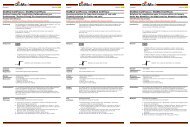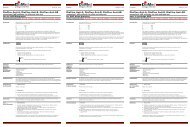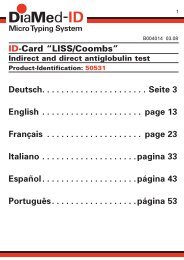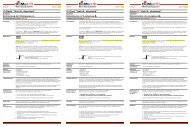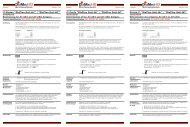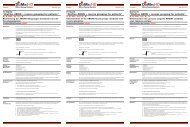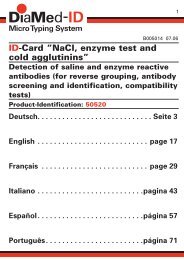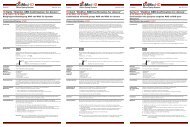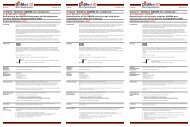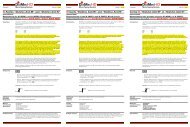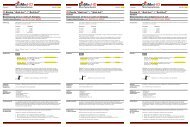Create successful ePaper yourself
Turn your PDF publications into a flip-book with our unique Google optimized e-Paper software.
Remark : For washing solution (R2, label identification : 10 x coloured blue), peroxidase substrate buffer (R8,<br />
label identification : TMB buf, coloured blue), chromogen (R9, label identification : TMB 11x, coloured purple)<br />
and stopping solution (R10, label identification : 1N coloured red), it is possible to use other lots than those<br />
contained in the kit, provided the same lot is used within a given test run. These reagents can be used with<br />
some other products of our company. Contact our technical service for detailed information.<br />
• Before use, it is required to wait 30 minutes to allow the reagents stabilizing at room temperature (18-30°C).<br />
• Do not carry out the test in the presence of reactive vapours (acid, alkaline, aldehyde vapours) or dust that could<br />
alter the enzymatic activity of the conjugate.<br />
• Use glassware thoroughly washed and rinsed with distilled water or preferably, disposable material.<br />
• Do not allow the micoplate to dry between the end of the washing operation and the reagent distribution.<br />
• Use a new dispensing tip for each sample.<br />
• Check pipettes for accuracy and precision and if the instruments being used are correctly working.<br />
• Washing : Carefully follow the washing procedures described to obtain mawimum test performance.<br />
• Never use the same container to dispense conjugate and color development solution.<br />
• The enzyme reaction is very sensitive to metal ions. Consequently, do not allow any metal element to come into<br />
contact with the various conjugate or substrate solutions.<br />
• The development solution (substrate buffer + chromogen) must be coloured pink. The modification of this pink<br />
colour within a few minutes after reconstitution indicates that the reagent cannot be used and must be replaced.<br />
Preparation of the development solution can be made in a clean disposable single use plastic tray or glass<br />
container that has first been pre-washed with 1N HCl and rinsed thoroughly with distilled water and dried. This<br />
reagent must be stored in the dark.<br />
7 - COLLECTION AND HANDLING OF SPECIMENS<br />
Collect a blood sample according to the current practices.<br />
Serum, plasma, or cell culture samples may be used. The following anticoagulants have been evaluated and found<br />
to be acceptable: EDTA, heparin, sodium citrate, CPDA-1, and ACD. Samples which are collected into anticoagulant<br />
tubes should completely fill the tube as labeling indicates to avoid improper dilution.<br />
Remove the serum or plasma from the clot or red cells as soon as possible to avoid hemolysis. Extensive hemolysis<br />
may affects test performance. Specimens with observable particulate matter should be clarified by centrifugation<br />
prior to testing. Suspended fibrine aggregates or particles may produce falsely positive results.<br />
Cell culture samples that require dilution prior to testing may be diluted with cell culture medium that is equivalent to<br />
that used to culture the cells.<br />
DO NOT USE HEAT-INACTIVATED SPECIMENS.<br />
The samples should be stored at +2-8°C if the screening is carried out within 7 days or deep-frozen at –20°C. The<br />
plasma must be quickly thawed by warming for a few minutes in a water bath at 40°C (to avoid fibrin precipitation).<br />
Given <strong>HIV</strong> <strong>Ag</strong> instability, temperatures over 40°C cannot be used.<br />
Samples that have been frozen and defrozen more than 3 times cannot be used.<br />
If the specimens are to be shipped, they must be packaged in accordance with the regulations in force regarding<br />
the transport of aetiological agents.<br />
DO NOT USE CONTAMINATED, HYPERLIPAEMIC OR HYPEHAEMOLYSED SERA OR PLASMA.<br />
Remark : Samples containing up to 80 mg/l bilirubin, 36 mg/l Immunoglobulin M or G, lipemic samples containing<br />
up to the equivalent of 5 g/l lipides, and hemolyzed samples containing up to 5 g/l hemoglobin do not affect the<br />
results.<br />
8 - RECONSTITUTION OF THE REAGENTS<br />
Note : Before use, allow reagents to reach room temperature (18-30°C) except concentrated conjugate 1 and 2 (R4<br />
and R5).<br />
Reagent R1 : Microplate<br />
Each tray containing 12 strips is wrapped in a sealed foil-lined bag. Cut the bag with scissors or a scalpel 0.5 – 1<br />
cm above the line. Open the bag and remove the tray. Return unused strips in the bag. Re-seal the bag and return<br />
to +2-8°C.<br />
Reagent R3 : Specimen Diluent<br />
Reagent C0 : Negative Control Serum<br />
Reagent C1 : Positive Control Serum<br />
Reagent R10 : Stopping Solution<br />
8




